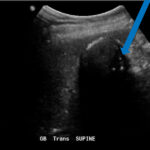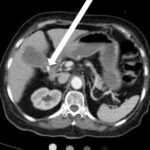A Case Report on Detecting Porcelain Gallbladder form Wall-Echo-Shadow Sign on Point-of-Care Ultrasound
ABSTRACT:
Point-of-Care Ultrasound (POCUS) is a rapidly growing means of accelerated diagnosis for various conditions. This case report demonstrates POCUS use to differentiate porcelain gallbladder (PGB) from wall-echo-shadow (WES) sign.
A 75-year-old female presented for evaluation of elevated liver function tests (LFTs). Upon arrival, she had no acute complaints with unremarkable vital signs, aside from elevated blood pressure of 155/79 mmHg. Review of LFTs demonstrated elevation of total bilirubin, aspartate aminotransferase (AST), alanine aminotransferase (ALT), and alkaline phosphatase (ALP). Physical examination and review of systems were unremarkable. POCUS revealed common bile duct dilatation with cholelithiasis and sludge. While these findings may be confused with a WES sign, POCUS also revealed a hyperechoic gallbladder wall (GBW) with shadowing and irregular clumps of echo. The hyperechoic GBW with irregular shadowing heightened the suspicion for PGB. Computed tomography scan confirmed the presence of PGB. The patient had a stent placed near the common hepatic duct stricture and was advised to return for cholecystectomy. She was readmitted three months later due to bacteremia, likely caused by gallbladder obstruction in the setting of gallbladder cancer.
Point of care ultrasound can be used to identify PGB. Because PGB has been associated with gallbladder carcinoma, prompt diagnosis is vital in early and aggressive treatment. In this case report, we demonstrate a reliable method in properly diagnosing PGB through POCUS.
Topics:
Point-of-care ultrasound, ultrasound, porcelain gallbladder, WES sign, wall-echo-shadow sign.





